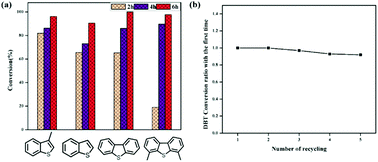Reduced graphene oxide: a metal-free catalyst for aerobic oxidative desulfurization†
Abstract
Nanocarbons have been extensively used as metal-free alternatives to metal catalysts in many oxidative processes owing to their functional groups or defects, which have the activation ability toward oxygen molecules. Herein, reduced graphene oxide (rGO) could be used as catalysts in oxidative desulfurization reactions for the first time to remove sulfur-containing compounds from fuels. Superior catalytic activity and stability are obtained in the aerobic oxidative desulfurization process catalyzed by rGO. A broad range of sulfur-containing aromatic substrates could be removed effectively in this catalytic system. Carbonyl groups have proved to play crucial roles during the oxidation process based on an XPS analysis, a chemical titration method and a series of comparative experiments. The chemically active defects are also beneficial to the catalytic performance because carbonyl groups could be generated in situ on these defects under the reaction conditions. Based on the EPR results, a radical pathway is proposed. Oxygen molecules could interact with the carbon atoms adjacent to carbonyl groups to form adsorbed super oxygen anion radicals (rGO-OO˙−), which then attack the adjacent sulfur-centered cation radicals and generate the final product sulfone.



 Please wait while we load your content...
Please wait while we load your content...